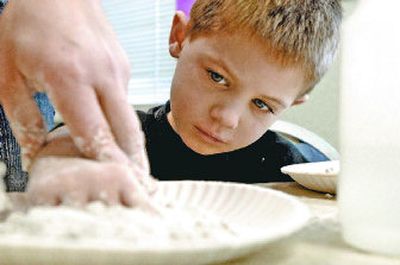The rights of children illuminated through art

As 5-year-old Franklin Moore watched plaster ooze over his little hand last month, he listened to his mother talk about the art project he was helping create.
“Your hand is actually going to be holding a sign that says ‘slow down for kids,’ ” Rachel Dolezal told him. “You think people should slow down for kids?”
Franklin nodded.
“What happens if adults don’t protect kids?” Dolezal asked.
“They will die,” Franklin responded.
“Is that OK?” she asked him.
“No, because it would be so, so mean.”
The plaster mold of Franklin’s hand is part of an art display for Coeur d’Alene’s Human Rights Education Institute’s Rights of the Child exhibit, which debuted this week as part of National Child Abuse Prevention Month.
Franklin and other children from School Indigo – a private school that closed last month because of financial problems – worked with Dolezal, the school’s art teacher, to produce five collaborative pieces for the display: a quilt made of children’s drawings and scraps of clothes; a collection of plaster hands and arms holding signs related to children, centered around a life-size stop sign; a collection of handmade bottle dolls; a display of essays, drawings and paintings; and a poster of 120 handprints, all but three brightly colored.
The 117 colored handprints on the poster represent the average number of children who die from abuse each month in the United States, Dolezal said. The three non-colored handprints represent the children who’ve yet to die from abuse but will by the end of the day. The actual number is between three and four, Dolezal said.
“The biggest thing to me is changing the adult perspective,” she said. “It’s not the children who are causing maltreatment.”
The exhibit, which runs through June, includes 35 original pieces of art created by local students – paintings, poems, photographs and essays. A multimedia art exhibit by residents at Coeur d’Alene’s Anchor House, a home for troubled teens, is displayed in a room off the main exhibit. Thirty of the pieces from the main exhibit were made into framed posters and will become part of a traveling national exhibit.
The work centers around the rights of the child, as written in a United Nations resolution passed nearly 50 years ago. The U.N.’s statement details the basic human rights all children should have, including the right to education, to be safe and healthy, to a name and nationality, to be protected from violence, and to play with one another.
Each of the 10 principles and the rights that go with them are represented in the art exhibit through paintings, photographs, poems and sculptures.
The point is simple: promote respect and awareness for children by teaching the community about the rights of children.
“A lot of people, I think, don’t realize the United Nations has made a declaration of the rights of the child,” Dolezal said.
A major piece of the project is the collection of hands holding signs touting child safety. The youngest Indigo students made the hand molds. Older students made the plaster arms that hold the hands, and the signs that the hands hold.
One “school zone” sign had holes punched in it by 9-year-old Dominic Patano, a fifth-grader. It resembled a sign in Israel the boy and his classmates saw in a picture. Those holes, however, weren’t punched with a pencil – they were ripped with bullets from a gun.
“It just looked weird,” Dominic said. “At first we thought that the painters did something.”
But when he and his classmates realized the holes were from bullets, they decided it was important to include in the exhibit.
“This is how unsafe it is for kids (in some parts of the world),” Dominic explained as he jabbed a pencil into the paper sign. “Just walking to school you could get shot.”
Hannah Huggins, 11, made the “slow down for kids” sign.
“We need to be more aware of children and what they do. We just really need to watch out for them,” she said.
Hannah and a few of her classmates also painted self-portraits that will be part of the exhibit. The kids were told to use colors and words throughout the painting that represented who they were and how they felt about themselves. Respect for oneself and others is a major component of the project, Dolezal said.
“Dehumanizing or disrespecting a person is where abuse starts, typically,” she said.